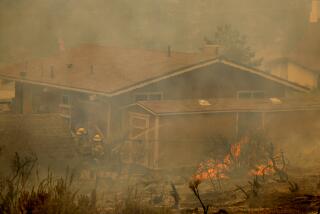Gel’s a good idea, but so is prevention
It doesn’t make sense to stock up on fire-retardant gel and then skip fire-prevention basics, said Karen Terrill, spokeswoman for the California Department of Forestry and Fire Protection in Sacramento.
Although the department supports homeowners’ use of fire-retardant gels, “it’s also important for people to obey the law,” she added, regarding clearing brush and removing items that can provide fuel for a fire.
According to California Public Resources Code 4291, homeowners with property adjoining mountainous areas, forest-covered lands or any areas covered in flammable material must:
* Clear brush and weeds a minimum of 30 feet from the home. (A 100-foot clearance is recommended.)
* Remove flammable material, such as leaves and pine needles, from the roof.
* Trim tree branches to keep them a minimum of 10 feet from chimneys. (Trimming to keep branches a minimum of 10 feet from the roof itself is also recommended.)
* Install a spark arrester (a half-inch wire-mesh screen) on all chimneys.
Fines for code violations can equal $270 per offense, according to the Superior Court of California.
The entire text for Code 4291 is available at www.fire.ca.gov/php/educationpubliccode4291.php.
In addition, firewood, cans containing flammable liquid and any other flammable items should be removed from the area surrounding the house, according to Terrill.
For homes on slopes, homeowners should clear a larger area than the minimum required by law. “Fire burns faster uphill,” she said. “Just light a match and turn it upside down, and you’ll see what I mean.”
Trimming tree branches so that you can walk under them helps keep branches from becoming “ladder fuel” in the case of a grass fire.
“We have about 6,000 grass fires each year in California,” Terrill said. “The key is to deny the fire fuel.”
Sometimes homeowners with the best intentions can accidentally cause the problems they’re trying to prevent.
“When you live in the city, you can mow the grass any time of day,” Terrill said.
But in a wilderness area, all mowing and trimming should be done early in the day, when morning dew helps make potentially flammable materials less likely to catch fire.
“When you’re mowing or using an edger, it’s easy to chip a rock and throw a spark into a wild area,” she said.
-- Kathy Sena
More to Read
Sign up for Essential California
The most important California stories and recommendations in your inbox every morning.
You may occasionally receive promotional content from the Los Angeles Times.










